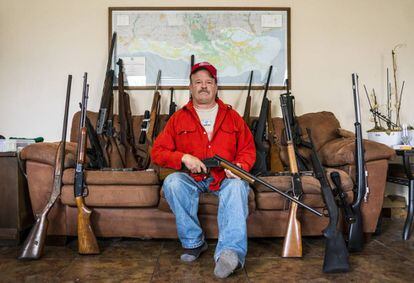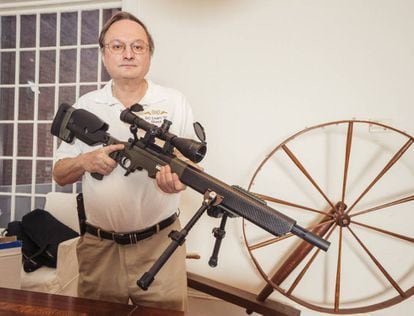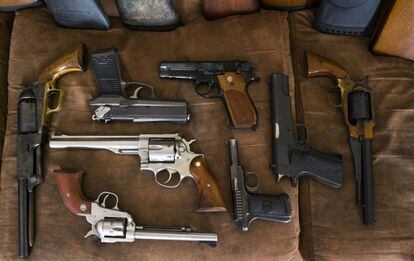America’s gun arsenal
When a 19-year-old with mental health issues went by his old school and massacred 17 people, the debate on gun control flared once more in a country with almost half the civilian firearms in the world. Despite the evidence, here’s why some gun owners won’t budge


Scott Porter owned his first firearm when he was just 13. It was a .20 caliber rifle, the same one his brother Ross had. His mother gave it to him for Christmas and he learned to hunt with it in his hometown in Michigan. He got his second gun when he was 18, this time a .22 caliber rifle. And then he got five more. As time went on, he stockpiled 14 different kinds of handguns. And also four assault rifles, six hunting rifles, four air rifles, two black powder guns and two vintage military models that he handles like babies. The sum total is 42 firearms, an arsenal he built up with Ross, who died two years ago. He keeps them at home in Baton Rouge, Louisiana, where he lives with his partner. And when asked why so many, he simply replies: “It’s just that I like them. I love guns; I’ve always been a hunter.”
On February 14, a 19-year- old with mental health issues called Nikolas Cruz showed up at his old school in Florida with an assault rifle and killed 17 people –14 teenagers and three school workers – in a hail of bullets. There appears to have been no motive. Every time this kind of mass shooting occurs, Scott Porter gets hot under the collar as the debate on firearms is rekindled. And the same question is asked for the umpteenth time: Why, after so many mass shootings, does America not do something about gun control?
“I get real angry because everyone thinks you can blame the firearms,” says Porter, who works as a technician. “But the problem is the nutcases. A lot of people might say I must be a gun freak having so many guns, but I’ve got them because we’ve collected them over the years and I like them.”

Less than 5% of the world’s population resides in the US and yet they have more than 40% of civilian firearms. Though there is no official figure, it is estimated that this amounts to as many as 350 million – that is, more guns than people. According to Pew Research, 30% of adults own one or more firearms and another 30% plan on getting one.
George L. Lyon opens the door to his home in Washington D.C. with a pistol tucked into his holster. His collection contains all sorts of firearms, but what he usually carries when he leaves the house is a Glock 43, a Glock 26 or a Smith & Wesson 5. A gun-rights lawyer and firearms instructor, he litigated against the District of Columbia some years ago to overturn legislation against carrying guns outside the home. Now, with a selection of rifles and revolvers spread across his dining room table, he explains what he likes to carry in summer and what is better in winter, and why he feels the constant need to carry one as though it were a cell phone and not a deadly weapon.
The massacres have international repercussions but these killings are a national issue
“You never know what is going to happen. The world can be a dangerous place. And I can’t carry a cop. They’re much too heavy,” he says. “A firearm is an emergency rescue tool, sort of like a fire extinguisher. You don’t need a fire extinguisher until you need it badly. It’s the same thing with a gun. You don’t wait to have a fire and then go out to buy a fire extinguisher, because that’s too late.”
There are those who thought the mass shooting at Sandy Hook Elementary School in Newtown, Connecticut would be the turning point in America’s love affair with guns. That’s where Adam Lanza shot 20 children between the ages of six and seven as well as seven adults on December 14, 2012. The incident sent shock-waves around the world and Barack Obama shed tears in public. But the sales of firearms skyrocketed in the wake of the massacre, and this was put down to fear of upcoming gun control measures.

The measures, however, never materialized. The demand for stricter gun control, supported by 60% of Americans, was a non-starter in Congress. The enthusiasm for firearms in America has much to do with a deeply-rooted individualistic attitude to self-defense. There is a widely held suspicion that if things turn ugly, the authorities are unlikely to be there to help. The gun rights groups usually throws out questions such as: ‘How can you stop a family living in isolated conditions from having a gun when it would take the police 40 minutes to get to them by car?’ There are millions who live in these kinds of circumstances. Then there are those who believe that the right to carry a gun is linked to identity and any criticism is seen as an attack on the American lifestyle, an idea espoused by the National Rifle Association (NRA).
“I grew up in a family that came from the Soviet Union,” says Gabriella Hoffman, 26, from Springfield, Virginia, who is on her way to target practice with her 9mm Smith handgun. “Some of our relatives were arrested by the Politburo and sent to labor camps. They were stripped of the right to defend themselves. If they had had weapons, not so many people would have died.”
The American media reports a rise in gun sales to African Americans and members of LGTB communities, thought to be a defense against hate crimes. In general, there are many more male gun owners than female, and more Republicans than Democrats. Hoffman, a media consultant, tells the story of a student who was raped when a man entered the window of her apartment on campus. “If she had been allowed to have a firearm, she would have been able to defend herself,” she says. “As a woman and a rather small one, I don’t want to be vulnerable. And it’s my constitutional right.”
The right to bear firearms is enshrined in the Second Amendment of the US Constitution. The controversy is over how this right is interpreted, what restrictions should be applied and how such a right can mean that someone not yet of legal age for beer can buy a semi-automatic AR-15, the weapon used by Nikolas Cruz in Florida.
Columbine, 1999, 13 dead; Virginia Tech, 2007, 32 dead; Las Vegas, 2017, 58 dead. The massacres have international repercussions but these killings are a national issue.
Enthusiasm for firearms in America has much to do with a deeply-rooted individualistic attitude to self-defense
Since the start of 2018, more than 1,800 people have died from gunshot wounds, according to the Gun Violence Archive. In January a 15-year- old boy killed two teenagers in a Kentucky high school but the tragedy was scarily considered too commonplace to make headlines.
Hoffman is a member of the NRA and trots out all the usual arguments: it’s the people, not the guns, that kill; introducing more restrictions makes no difference since the crimes are committed by evil people who don’t respect the law. According to Hoffman, a lot of those wanting stricter measures don’t realize that the law already bans offenders and domestic abusers from buying a weapon. Regarding the most recent high school shooting, gun rights groups point out that the FBI had done nothing about Cruz despite being alerted to his state of mind. But despite what Donald Trump had to say on Twitter about their lack of focus on real crime, it is hard to see how the authorities can keep an eye on every potentially dangerous person in a country with more than 300 million firearms.
The lone-wolf, mass-shooting phenomenon is peculiar to the US and makes it impossible to dismiss the fact that a gun can be procured here with ease. Adam Lankford from Alabama University produced a comparative study of 171 countries some years back. It showed that 31% of the killings between 1966 and 2012 had taken place on US soil. “America, Yemen, Switzerland, Finland and Serbia are the countries with most firearms per capita and in the study they emerge among the 15 with the most killings,” he says.

After every shooting, it is the same story. There is fury on a national level, global incredulity, and a rise in gun sales. Each US state interprets the Second Amendment differently, reflecting the diversity of the country. There are very lax states such as Arizona where there’s no need for a permit to carry an unconcealed weapon. And at the other end of the spectrum, California has outlawed the bearing of assault rifles. As Scott Porter says, people have so many weapons at home that it is a hard issue to tackle. Last Friday, it seemed possible that the sale of ammunition to people with mental health issues might be stopped. Too late, however, for the 17 people in Florida who died at the hands of Nikolas Cruz and his AR-15, known as ‘America’s rifle’, which he carried to Marjory Stoneman Douglas High School with evil intent and absolute impunity.
English version by Heather Galloway.

